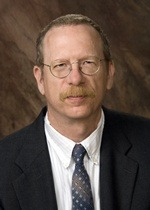by David Hedin, NIU Board of Trustees Professor of Physics
NIU physicists and students played a major role over the years in the design and construction of elements of a detector at Fermilab used to identify subatomic particles known as muons. That science is now helping scientists shed new light on what the New York Times calls “one of the biggest mysteries of cosmology”—why the universe is made up of matter.
Fermilab made news worldwide in May, announcing that scientists in the DZero collaboration there had discovered a potential clue in the matter-antimatter mystery that has challenged the great minds in physics for decades.
Two thousand years ago, natural philosophers conjectured that the underlying structures of our universe were symmetric, such as circles or spheres.
We now know it is the asymmetries in nature that define its history and our existence. In fact, a perfectly symmetric universe would be lifeless because equal amounts of matter and antimatter would have annihilated each other in the first instance of creation.
Yet the Standard Model of Physics, which is the best explanation scientists have of the origins of the universe, doesn’t explain matter’s dominance over its antithesis.
Somehow, when our universe began about 13 billion years ago in a state of very high temperature and density (the so-called Big Bang), matter began to dominate, albeit ever so slightly.
A very tiny amount of matter, a fraction of less than 1 in a billion, survived to form all the stars, all the planets, and all of us. Without this asymmetry, we would not exist.
For more than 50 years, experiments at particle physics centers such as Fermilab have tried to study particle-antiparticle differences. Such differences have been observed but were too small to explain the dominance of matter.
The new result from the DZero experiment, however, found evidence of a much larger effect.
DZero collaborators studied seven years’ worth of data with more than 200 trillion proton-antiproton collisions. They found a 1 percent difference between the production of pairs of muons and pairs of antimuons in the decay of subatomic particles known as B mesons. If the excess holds up, this result from DZero could point to new physics that could explain the excess of matter in the early universe.
The design, construction and operation of the DZero detector requires the dedicated work of a collaboration of about 500 physicists, and NIU students and faculty have been members of the collaboration since 1986.
I helped design and construct the muon system and led the group responsible for the software algorithms used to define muons for 16 of the past 25 years. Further, between 1987 and 2001, more than 90 NIU students worked on building and testing muon system components.
NIU also made significant contributions to the system used to collect data and quickly identify collisions containing muons. The group that designed the system was led by Distinguished Research Professor Gerald Blazey. In fact, optimizing the data-collection efficiency was Blazey’s highest priority while he was co-spokesperson of DZero from 2002 to 2006.
Additionally, Physics Professor Michael Fortner and Research Scientist Sergey Uzunyan built a component of the muon logic circuits.
High energy physics experiments such as those at Fermilab are often referred to as “big science.” They are massive and often expensive undertakings, but there are big payoffs, too. These experiments are helping us answer age-old questions and better understand the building blocks of our universe.
David Hedin is the founding faculty member of NIU’s experimental high energy physics group and has been conducting research at Fermi National Accelerator Laboratory since 1976.

